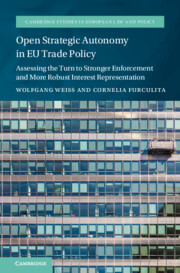 Open Strategic Autonomy in EU Trade Policy
Open Strategic Autonomy in EU Trade Policy Is There a Place for Unilateralism under International Rules?
from Part II - The Tools for Stronger Enforcement of Trade Rights
Published online by Cambridge University Press: 29 November 2024
Chapter 6 analyses the Anti-Coercion Instrument (ACI), which seeks to enable the Union to respond to economic coercion applied by third states. The chapter presents the rationale and scope of the instrument, as well as the procedures prescribed by it. In addition, it provides an extensive analysis of the instrument’s compliance with EU’s international commitments. It first assesses the ACI in view of international customary rules invoked by the EU as a legal basis, especially the principle of non-intervention and its application to economic coercion. Then it examines the ACI in light of WTO procedural and substantive rules that, as argued by the authors, supersede the general international law customary norms, and the possible justifications of a finding of violation. The chapter then complements the analysis with an evaluation of the ACI’s consistency with bilateral trade rules inscribed in EU FTAs. Finally, it contemplates other costs and benefits associated with the ACI besides its legality under international law rules, evaluating whether the adoption of the ACI is worth taking the risks, considering EU’s multilateralist stance.
To save this book to your Kindle, first ensure [email protected] is added to your Approved Personal Document E-mail List under your Personal Document Settings on the Manage Your Content and Devices page of your Amazon account. Then enter the ‘name’ part of your Kindle email address below. Find out more about saving to your Kindle.
Note you can select to save to either the @free.kindle.com or @kindle.com variations. ‘@free.kindle.com’ emails are free but can only be saved to your device when it is connected to wi-fi. ‘@kindle.com’ emails can be delivered even when you are not connected to wi-fi, but note that service fees apply.
Find out more about the Kindle Personal Document Service.
To save content items to your account, please confirm that you agree to abide by our usage policies. If this is the first time you use this feature, you will be asked to authorise Cambridge Core to connect with your account. Find out more about saving content to Dropbox.
To save content items to your account, please confirm that you agree to abide by our usage policies. If this is the first time you use this feature, you will be asked to authorise Cambridge Core to connect with your account. Find out more about saving content to Google Drive.